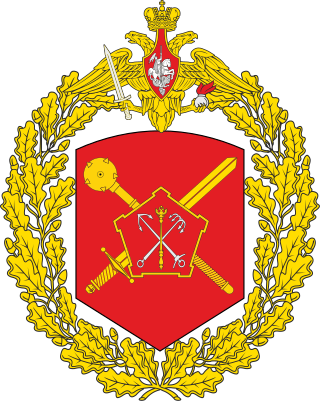Related Research Articles
The Southern Front was a front, a formation about the size of an army group of the Soviet Army during the Second World War. The Southern Front directed military operations during the Soviet occupation of Bessarabia and Northern Bukovina in 1940 and then was formed twice after the June 1941 invasion by Germany, codenamed Operation Barbarossa.

The 6th Army is a field army of the Red Army and the Soviet Army that was active with the Russian Ground Forces until 1998, and has been active since 2010 as the 6th Combined Arms Army.
The 18th Army of the Soviet Union's Red Army was formed on 21 June 1941 on the basis of HQ Kharkov Military District and armies of the Kiev Special Military District.
The 52nd Rifle Division was an infantry division of the Red Army during the Russian Civil War, the interwar period, World War II, and the Cold War, formed once during the Russian Civil War and three times during the existence of the Soviet Union.
A rifle corps was a Soviet corps-level military formation during the mid-twentieth century. Rifle corps were made up of a varying number of rifle divisions, although the allocation of three rifle divisions to a rifle corps was common during the latter part of World War II.

The 97th Guards Mechanized Brigade was a rifle, and then a motor-rifle division of the Soviet Union's Army, before becoming a mechanized brigade of the Ukrainian Ground Forces, based in Slavuta in western Ukraine.

The 22nd Mechanized Brigade is a formation of the Ukrainian Ground Forces. It traces its origins to the 66th Guards Rifle Division, originally a formation of the Red Army and later of the Soviet Ground Forces.
The 47th Army was a field army of the Red Army during World War II, active from 1941 to 1946.
The 266th Rifle Division was a rifle division of the Soviet Red Army during World War II. The 266th was formed three times during the war.
The 11th Tank Division was a Soviet tank division initially formed in 1940 at Tiraspol and destroyed in 1941; it was then formed as a tank corps in May 1942. This unit was subsequently reorganized as the second formation of the 11th Tank Division in 1945.
The 102nd Rifle Division was an infantry division of the Red Army which participated in the Second World War. It was formed three times. Its first formation was listed as part of the active army from 2 July to 19 September 1941. Its third formation was awarded the Order of Lenin, the Order of the Red Banner, and the Order of Suvorov, 2nd class.
The 1st Army Corps was an army corps of the Soviet Armed Forces. It was formed in 1957 and finally deactivated in 1991. It draws its history from the 1st Rifle Corps, formed in 1922. Troops of the 1st Rifle Corps participated in the Winter War and World War II.

The 252nd Rifle Division was the eighth of a group of 10 regular rifle divisions formed from cadres of NKVD border and internal troops as standard Red Army rifle divisions, very shortly after the German invasion, in the Moscow Military District.
The 7th Rifle Corps was a corps in Red Army and Soviet Armed Forces, before and during The Great Patriotic War/World War II.
The 301st Rifle Division began service as a standard Red Army rifle division shortly after the German invasion, but was soon largely destroyed in the encirclement of Kiev, although enough of a cadre survived to form the basis of a second formation. This new division began forming in the last days of 1941, and saw some limited service in the Second Battle of Kharkov, but then had to fall back in the face of the German summer offensive, became encircled quite early on, and had to be disbanded in July. Nearly a year later a third 301st was raised, based on the personnel and equipment of two existing rifle brigades. This incarnation of the division compiled a creditable record of service in several major offensives through Ukraine, then into Poland and into the heart of Berlin in April, 1945, and also served briefly post-war in the Group of Soviet Forces in Germany, headquartered in Berlin.

The 51st Rifle Division was an infantry division of the Soviet Army, formed twice. Its first formation was formed during the Russian Civil War and fought in the Perekop-Chongar Offensive in 1920. It also fought in the Soviet invasion of Poland, Winter War and World War II. During World War II, it fought in the Battle of Rostov, Barvinkove-Losowaja Operation and Second Battle of Kharkov before being destroyed at the Battle of Voronezh. Officially disbanded on 28 November 1942, the division was reformed on 15 April 1943 from the 15th Rifle Brigade. The 2nd formation fought in Operation Bagration and the Battle of Königsberg. It was disbanded in an executive order by Premier Joseph Stalin in 1946.
The 295th Rifle Division was an infantry division of the Soviet Union's Red Army and later the Soviet Army, formed twice.
The 15th Rifle Corps was a rifle corps of the Red Army, formed five times; each formation was a distinct unit unrelated to the others. It was part of the 5th Army. It took part in the Soviet invasion of Poland in 1939.

The Kharkov Military District was a military district of the Russian Empire, the Russian Soviet Federative Socialist Republic, and the Soviet Union. Throughout its history, the district headquarters was located in the city of Kharkov in northeastern Ukraine.

Alexander Stepanovich Kostitsyn was a Red Army major general killed during World War II.
References
- ↑ Bonn, Slaughterhouse, 2005, 342.